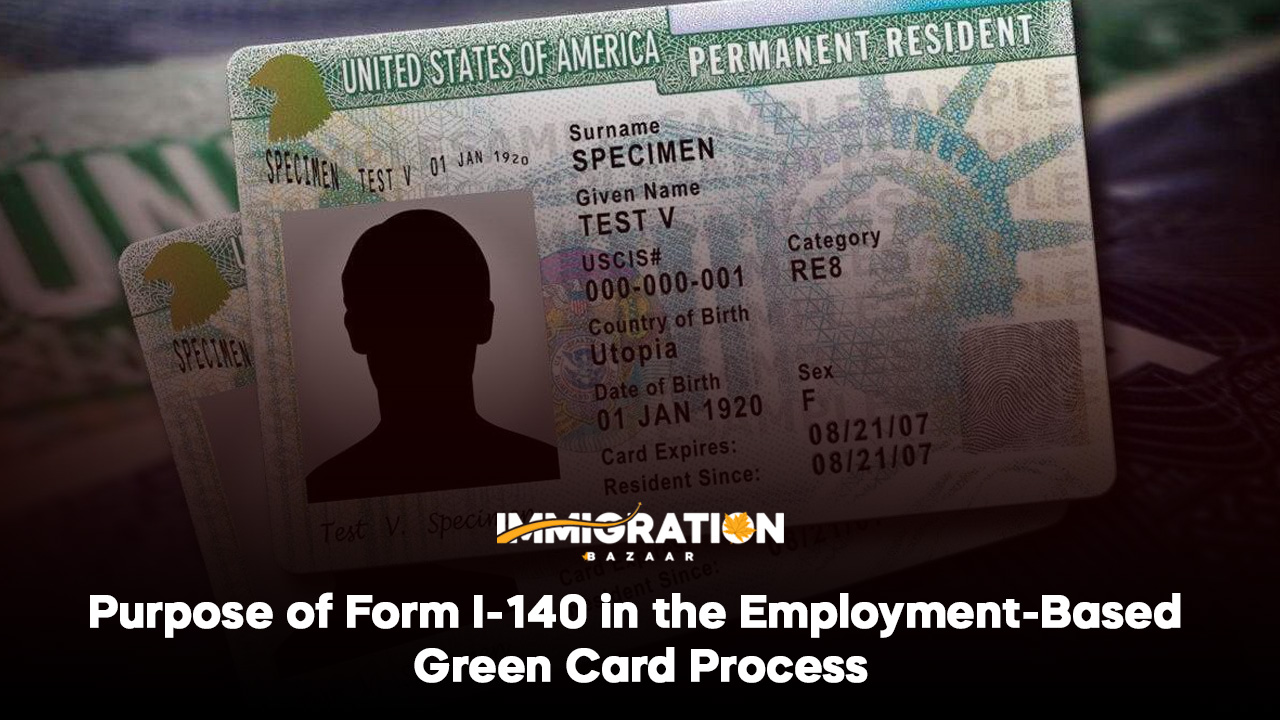Applying for a Green Card through employment in the U.S. involves several key steps, and Form I-140, the Immigrant Petition for Alien Worker, is one of the most critical components. This form is filed by an employer on behalf of a foreign worker seeking permanent residency in the United States and serves as proof of the worker’s eligibility for a Green Card.
Here, we’ll cover the essential aspects of Form I-140, eligibility criteria, employment-based immigration categories, filing procedures, required documentation, and other critical considerations for those navigating the Green Card application process through employment.
-
Purpose of Form I-140 in the Employment-Based Green Card Process
Form I-140 serves as the basis for employment-based immigration applications. It establishes that a foreign worker is qualified for a particular employment-based visa preference category (such as EB-1, EB-2, or EB-3) and that a U.S. employer is offering a job that meets the criteria for permanent residency. Form I-140 is required for most employment-based Green Cards, except for specific circumstances where self-petition is permitted.
Filing Form I-140 is generally a step toward the final Green Card application (Form I-485 or consular processing) once the priority date becomes current. Form I-140 approval by the U.S. Citizenship and Immigration Services (USCIS) does not directly grant the applicant lawful permanent residency, but it is a critical prerequisite.
-
Employment-Based Immigration Categories
Form I-140 applies to three main categories of employment-based Green Cards:
- EB-1 (Employment-Based First Preference): This category is for individuals with extraordinary abilities in sciences, arts, education, business, or athletics; outstanding professors and researchers; and multinational managers and executives.
- EB-2 (Employment-Based Second Preference): This category covers professionals with advanced degrees and individuals with exceptional ability in specific fields. Certain subcategories under EB-2, like the National Interest Waiver (NIW), allow applicants to self-petition without a job offer.
- EB-3 (Employment-Based Third Preference): This category includes skilled workers, professionals, and unskilled workers. EB-3 typically has a longer waiting period than EB-1 and EB-2, as it includes a broader range of applicants.
Each category has specific eligibility requirements and may require labor certification (PERM) depending on the type of role and level of skill.
-
Eligibility and Documentation Requirements
To file Form I-140, an employer must demonstrate that the foreign worker meets all eligibility requirements. Required documentation for I-140 applications may include:
- Job Offer: A permanent, full-time job offer from a U.S. employer that qualifies under the chosen employment-based category.
- Labor Certification (PERM): For EB-2 and EB-3 categories, the employer generally needs to provide an approved labor certification from the U.S. Department of Labor (DOL) as proof that they tried to recruit U.S. workers but were unable to find qualified candidates. This is not required for the EB-1 category.
- Proof of Qualifications: Documentation such as educational degrees, professional licenses, awards, or publications may be required to prove the applicant’s qualifications.
- Employer’s Ability to Pay: The employer must show evidence of the ability to pay the offered wage, often through tax returns, financial statements, or annual reports.
The requirements can vary significantly depending on the specific employment category under which the worker applies, as higher preference categories (like EB-1) have more stringent criteria but generally fewer documentation requirements.
-
Filing Process for Form I-140
The Form I-140 filing process has several steps, typically handled by the sponsoring employer:
- Complete and Submit Form I-140: The employer completes Form I-140 and submits it to USCIS, along with the required documentation and filing fee. The current filing fee is $700, but this is subject to change, so it is important to check the latest fee structure on the USCIS website.
- Supporting Documentation: The application package must include evidence of the worker’s eligibility, the job offer, and proof of the employer’s ability to pay the wage. If applicable, an approved PERM labor certification must be submitted alongside the form.
- Optional Premium Processing: For an additional fee, some I-140 petitions are eligible for premium processing, which expedites USCIS review to 15 calendar days. This service is available for most employment-based categories except for certain self-petition cases, such as the National Interest Waiver.
- Processing Times: Standard processing times for Form I-140 can vary based on the USCIS service center and the employment-based category. Generally, it may take several months to over a year for approval, though premium processing can significantly reduce this timeframe.
- Request for Evidence (RFE): USCIS may issue an RFE if they need more information. The employer and applicant should respond to an RFE promptly to avoid delays or denials.
- Approval and Priority Date: Once Form I-140 is approved, USCIS assigns the applicant a priority date based on when the petition was filed. This date determines the applicant’s place in line for the Green Card, depending on their country of origin and preference category.
-
After Approval: Adjustment of Status and Consular Processing
Upon approval of Form I-140, the next step in the Green Card application process depends on the applicant’s location and visa availability:
- Adjustment of Status (Form I-485): For individuals already in the United States on a valid nonimmigrant visa, an I-485 application allows them to adjust their status to that of a permanent resident once their priority date is current.
- Consular Processing: For applicants outside the U.S., consular processing at a U.S. embassy or consulate in their home country is required. This involves a Green Card interview and biometric data collection.
Both pathways require additional steps, including background checks, medical exams, and interviews, but a Form I-140 approval moves the applicant significantly closer to permanent residency.
-
Unique Considerations for Form I-140
Portability of Approved I-140 Petitions
In certain cases, an applicant with an approved Form I-140 may switch employers without jeopardizing their Green Card process. Known as “porting,” this option is available if the I-485 application has been pending for at least 180 days and the new position is in the same or a similar occupation.
Country-Based Visa Limitations and Priority Date Backlogs
Due to per-country limitations, applicants from countries with high demand, such as India and China, often face longer wait times. Priority date backlogs can significantly delay Green Card processing, particularly for EB-2 and EB-3 categories, which have large applicant pools.
Self-Petition Options
While Form I-140 generally requires an employer’s sponsorship, certain categories, like the EB-1A for extraordinary ability and EB-2 with a National Interest Waiver, allow applicants to self-petition without an employer. This provides an alternative for individuals who meet specific requirements and do not have a job offer from a U.S. employer.
-
Common Challenges and Pitfalls in the I-140 Process
The Form I-140 process can be complex, and applicants and employers often face challenges, such as:
- Documentation Issues: Insufficient documentation or failure to provide detailed proof of qualifications can lead to delays or RFEs.
- Financial Viability of the Employer: USCIS requires evidence that the employer can pay the offered wage. If the employer’s financial situation is questionable, it can jeopardize the I-140 approval.
- Labor Certification Complexity: The PERM labor certification process can be lengthy and requires strict adherence to recruitment guidelines to ensure no qualified U.S. workers are available.
-
Recent Changes and Trends in Employment-Based Immigration
Given the evolving immigration landscape, keeping up with policy changes affecting Form I-140 and employment-based Green Cards is essential. Trends such as the introduction of priority processing for certain categories and legislative changes affecting per-country quotas are vital factors for applicants to monitor.
-
Conclusion
Form I-140 is a critical milestone in the employment-based Green Card application process, serving as a foundation for securing permanent residency. For international students and professionals aspiring to work and live in the United States, understanding the nuances of this form, eligibility requirements, and associated categories can pave the way for a smoother immigration experience. By ensuring accurate and complete submissions and staying informed about immigration policy updates, applicants can navigate the I-140 process more effectively.







